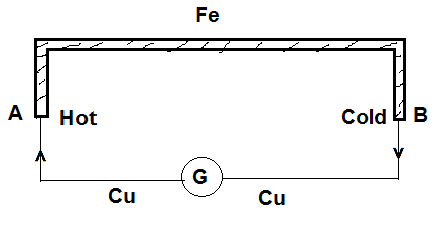Table of Contents
Seebeck Effect:
Take two dissimilar metals say iron and copper, joined together at junctions A and B, through a galvanometer G. When both the junctions are kept at same temperature; it is found that no current flows through the thermocouple (circuit).

Again, if one of the junctions say A is heated and the other junction say B is kept cold, then the galvanometer gives deflection i.e. current flows through the circuit. The current so produced is called thermoelectric current. This phenomenon is first of all discovered by Seebeck and hence it is also called the Seebeck effect.
Definition of Seebeck Effect:
This phenomenon of production of thermoelectric current, when the two junctions of thermocouple are kept at different temperature is called the Seebeck effect.
It should be noted that current flows at the hot junction from copper to iron.
Seebeck found that magnitude and direction of thermo e.m.f. depends upon-
- The nature of metals forming the thermocouple.
- The difference in temperature of the two junctions.
Again, the Seebeck effect is reversible i.e. if hot and cold junctions are interchanged, the direction of thermoelectric current is reversed.
Seebeck arranged different metals in the form of series called as Seebeck Series. The metals in the Seebeck series are bismuth, nickel, platinum, aluminium, lead, silver, gold, copper, zinc, iron, nichrome and antimony. According to Seebeck, current flows at the hot junction from the metal which comes earlier to the metal which comes later on in the Seebeck series. Further, the large the gap between the metals in the Seebeck series, forming the thermocouple, the greater will be the thermo e.m.f. produced. That is why the maximum thermo e.m.f is produced in the Sb-Bi thermocouple.
Origin of Seebeck Effect:
We know that number of electrons per unit volume (i.e. electron density) is different for different conductors. When two different metals are brought in contact, the free electrons tend to diffuse from the metal with greater electron density to the metal with lower electron density. Due to this diffusion, a potential difference is developed at the junction called contact potential.
When both the junctions are at the same temperature, the contact potential at the two junctions will be the same. Hence no current flows through the thermocouple. Now, if one of the junctions of the thermocouple is heated, there will be some potential difference at the two junctions, hence thermoelectric current flows through the thermocouple.









Comments (No)